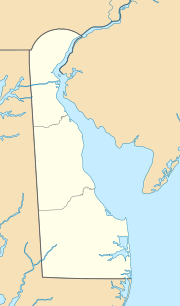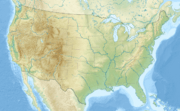Matson Run facts for kids
Quick facts for kids Matson Run |
|
|---|---|
|
Location of Matson Run mouth
|
|
| Other name(s) | Tributary to Shellpot Creek |
| Country | United States |
| State | Delaware |
| County | New Castle |
| City | Bellefonte |
| Physical characteristics | |
| Main source | Alapocas Run divide Blue Ball, Delaware 260 ft (79 m) 39°47′04″N 075°32′23″W / 39.78444°N 75.53972°W |
| River mouth | Shellpot Creek Bellefonte, Delaware 20 ft (6.1 m) 39°45′42″N 075°31′04″W / 39.76167°N 75.51778°W |
| Length | 2.25 mi (3.62 km) |
| Basin features | |
| Progression | generally southeast<ref name="geoviewer"> |
| River system | Delaware River |
| Basin size | 1.28 square miles (3.3 km2) |
| Tributaries |
|
| Bridges | Foulk Road, Weldin Road, I-95, Miller Road, W Lea Boulevard (x2) |
Matson Run is a small stream, or "run," located in New Castle County, Delaware. It is about 2.25 miles (3.62 km) long. This stream is special because it's a "first-order tributary." This means it's one of the smallest streams that flows into a larger one, which in this case is Shellpot Creek. Matson Run is the only stream with this name in the entire United States.
Other Names for Matson Run
Sometimes, places can have more than one name over time. According to the Geographic Names Information System, which is like a big dictionary of place names, Matson Run has also been known as "Mattsons Run" in the past.
Where Does Matson Run Flow?
Matson Run begins, or "rises," in an area called Blue Ball, Delaware. From there, it flows generally towards the southeast. Its journey ends when it joins Shellpot Creek in the town of Bellefonte, Delaware.
Matson Run's Watery Home
Every stream, river, or lake has a "watershed." A watershed is like a big bowl of land where all the rain and melted snow eventually drain into that specific body of water. Matson Run's watershed covers an area of about 1.28 square miles (3.32 square kilometers).
This area receives a good amount of rain each year, averaging about 47.2 inches (120 cm). About 11% of the land in Matson Run's watershed is covered by forests. These forests are important because they help keep the water clean and provide homes for wildlife.



